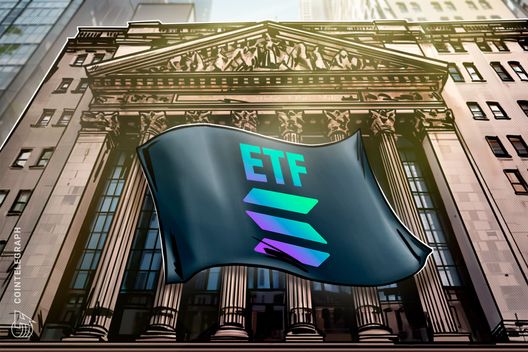
Paul Atkins wurde als 34. Vorsitzender der Securities and Exchange Commission vereidigt.

Finanzmittel Info + Krypto + Geld + Gold
Krypto minen, NFT minten, Gold schürfen und Geld drucken

Paul Atkins wurde als 34. Vorsitzender der Securities and Exchange Commission vereidigt.
Bitcoin has demonstrated notable strength in recent weeks, seemingly shrugging off the escalating trade tensions between the US and China that have unsettled broader financial markets.
This resilience, marked by a significant price increase, is fueling observations that the cryptocurrency is increasingly behaving like a traditional safe-haven asset, akin to gold, rather than mirroring the volatility often seen in tech-heavy indices like the Nasdaq.
In the two weeks leading up to April 22, Bitcoin registered a solid 12% price gain.
This upward movement occurred even as the trade dispute intensified, with the US imposing tariffs reported up to 125% on China, prompting reciprocal measures from Beijing.
Unlike many other assets sensitive to global trade disruptions, Bitcoin appeared relatively insulated, strengthening the argument for its potential role as a store of value during geopolitical uncertainty.
Alex Svanevik, CEO of crypto intelligence firm Nansen, highlighted this trend, noting Bitcoin’s apparent “decoupling” from traditional stock markets.
“Unlike altcoins and major indexes like the S&P 500, Bitcoin has remained relatively stable despite the global trade tensions,” Svanevik observed, according to the analysis.
However, he cautioned that while resilient to specific trade issues, Bitcoin remains susceptible to broader macroeconomic headwinds, particularly the growing fears of a potential economic recession.
Adding another layer to Bitcoin’s evolving status is the concept of a potential US Strategic Bitcoin Reserve.
Plans outlined in a presidential executive order suggest the government intends to hold Bitcoin, initially comprising assets seized in criminal investigations.
More significantly, the order details potential future strategies for acquiring more Bitcoin, possibly funded through tariff revenues or by re-evaluating the Treasury’s gold certificates to generate surplus funds, potentially avoiding the need to sell existing gold reserves.
Svanevik believes such “regulatory developments will play a significant role in Bitcoin’s growth as a global asset,” potentially enhancing its legitimacy and appeal.
While Bitcoin charts its course, the macroeconomic outlook remains clouded. Concerns about a potential US recession are intensifying, acting as a significant counterweight to bullish sentiment in risk assets.
A recent report from JPMorgan notably increased its estimated probability of a US recession occurring in 2025 from 40% to 60%.
The report underscored that existing tariffs, particularly citing the high 145% tariff on China in this context, continue to pose a “significant threat to global growth.”
Against this backdrop, the Federal Reserve is anticipated to begin easing monetary policy, likely starting in September 2025 with further rate cuts expected through January 2026.
While monetary easing could stimulate the economy, it might also influence demand dynamics for assets perceived as riskier, potentially including Bitcoin, depending on how investors weigh inflation hedges versus growth prospects.
Bitcoin’s trajectory appears increasingly shaped by a complex interplay of factors.
Its resilience during the recent trade friction supports the narrative of it maturing into a gold-like store of value.
Continued institutional interest and potential government actions like the Strategic Reserve could further solidify this perception.
However, the looming threat of a broader economic downturn and ongoing regulatory developments, particularly in the US, remain critical variables.
As global economic anxieties persist, Bitcoin’s ability to maintain its appeal as a hedge against turbulence will be closely watched.
The post Bitcoin gains 12%, mirrors gold as trade war, recession fears mount appeared first on CoinJournal.
After the dramatic 90% Mantra price crash on April 13, 2025, as a result of reckless liquidations, Mantra’s founder and CEO, John Patrick Mullin, has announced a bold plan to burn his personal allocation of 150 million OM tokens.
This move aims to rebuild trust in the Layer 1 blockchain focused on real-world asset tokenization.
While the April 13 crash wiped out over $5 billion in market capitalization in mere hours, Mullin’s commitment to burn tokens valued at approximately $82 million at current prices has stunned the crypto community.
An X poll conducted by John Patrick Mullin has garnered over 8,900 votes, with over 81% of respondents backing the immediate burning of his tokens.
This strong endorsement reflects the community’s desire for decisive action to try and help the OM token recover.
According to the burn proposal, the tokens, currently being unstaked, will be sent to the network’s burn address by April 29, 2025.
The process ensures transparency and adherence to protocol rules.
Mantra is also exploring a larger burn with ecosystem partners, with discussions underway to incinerate an additional 150 million OM tokens.
This would total to 300 million tokens being burned, or 16.5% of the 1.817 billion total supply.
Such a reduction could significantly alter the token’s supply dynamics.
If successful, the total OM token supply would drop to approximately 1.517 billion OM tokens.
The burn is expected to impact Mantra’s tokenomics positively.
It will reduce the bonded ratio from 31.47% to 25.30%. Staked tokens will decrease from 571.8 million to 421.8 million.
This adjustment will boost the staking APR for remaining tokens.
Higher staking rewards could incentivize holders to lock up their OM. Reduced selling pressure might support price stability.
However, despite the announcement, OM’s price has remained stagnant, currently trading at approximately $0.5396, up by only 0.1% in the past 24 hours.
Following the burn announcement, the token saw a slight uptick to an intraday high of $0.5585 before quickly falling back to the $0.50 range.
Presumably, the ongoing unstaking process may be delaying significant price movement, while market skepticism persists after the crash’s shock.
Approximately 4 million OM tokens unlock every few weeks, and with 45% of the supply still locked, selling pressure could counteract the burn’s benefits.
The April 13 crash raised suspicions of foul play, with community members accusing the Mantra team of orchestrating a sell-off, claims that Mullin and investor Laser Digital firmly denied.
Currently, OM’s price struggles to break above $0.55, especially with the ongoing unlocks and potential liquidations looming large.
Going by this, the market sentiment remains cautious, and the burn’s psychological impact may not fully materialize until it’s complete.
However, in the long term, the burn could lay a foundation for growth.
A 16.5% supply reduction is substantial, and coupled with staking incentives, it could tighten the circulating supply, leading to a normal supply-demand curve that could result in a hike in price.
The post MANTRA founder’s 150M OM burn proposal gets 81% support: can it spark a recovery? appeared first on CoinJournal.

Solana erlebt derzeit einen deutlichen Kursanstieg. Wir werfen einen Blick auf die Gründe.
Bitcoin exchange-traded funds (ETFs) in the United States posted their largest single-day net inflow in almost two months, with April 21 marking the strongest session since January 30.
The ETF inflow coincided with a sharp move in Bitcoin prices, which reclaimed the $91,000 level for a brief window before retracing to around $90,000.
Total inflows across Bitcoin ETFs reached $381.3 million on April 21, with ARK 21Shares Bitcoin ETF (ARKB) capturing the largest share at $116.1 million.
Fidelity Wise Origin Bitcoin Fund (FBTC) followed with inflows of $87.6 million.
Grayscale, which had previously struggled with outflows after converting its Bitcoin trust to an ETF, showed signs of stabilization as its Bitcoin Trust (GBTC) and Bitcoin Mini Trust ETF (BTC) recorded combined inflows of $69.1 million.
BlackRock’s iShares Bitcoin Trust ETF (IBIT), the largest Bitcoin ETF by assets under management, drew $41.6 million, down from pre-weekend levels on April 17.
Other funds, including HODL and EZBC, contributed $11.7 million and $10.1 million, respectively.
According to CoinShares’ latest report, the United States recorded total outflows of $71 million for the week, indicating that April 21’s activity was an outlier amid otherwise tepid sentiment.
In contrast, European markets maintained a more constructive stance toward digital assets.
Switzerland led the region with $43.7 million in net inflows, while Germany added $22.3 million. Canada also saw modest inflows of $9.4 million during the period.
CoinShares noted that overall digital asset investment products saw modest weekly inflows of $6 million.
Midweek, stronger-than-expected US retail sales figures triggered a sharp outflow of $146 million from digital asset funds, reflecting market sensitivity to macroeconomic data.
Bitcoin-specific products closed the week with net outflows of $6 million, despite the significant daily inflow figure on April 21.
Meanwhile, short Bitcoin products recorded their seventh consecutive week of outflows, with $1.2 million withdrawn, bringing total redemptions over the period to nearly 40% of assets under management.
The post Bitcoin ETFs see biggest inflows since January on Monday appeared first on CoinJournal.